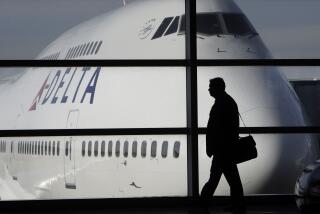Airline stocks drop, led by 33% decline of American parent AMR
Growing worries about the financial woes of American Airlines and concerns about the fiscal health of the industry led to major turbulence for airline stocks, especially American parent AMR Corp.
Shares of AMR plunged Monday, losing 33% of their value after a string of recent setbacks on Wall Street and fear that the company may seek bankruptcy protection.
An index of 15 major airline shares tumbled 9.8% on Monday to its lowest level since November 2009. The index is down 41% this year, compared with a 12.6% drop for the Standard & Poor’s 500 index. US Airways Group Inc. shares dropped 15.8% and JetBlue Airways Corp. slipped 14.7%.
AMR stock dropped 98 cents, to $1.98, after a report Monday that air travel demand worldwide has slowed and that the airline faces an unusually high number of pilots retiring early.
“Regarding rumors and speculation about a court-supervised restructuring, that is certainly not our goal or our preference,” said company spokesman Andrew Backover. “We know we need to improve our results, and we are keenly focused as we work to achieve that.” The company declined to comment on stock prices.
Industry analysts were divided on whether AMR would file for bankruptcy.
“They are not on the brink,” said Bob McAdoo, an airline analyst for Nashville-based Avondale Partners, who noted that American recently sold more than $700 million in bonds.
But Robert Herbst, an independent airline analyst and former airline pilot, believes a bankruptcy filing is the only way American can get out from under its financial problems.
“I believe that it’s inevitable that American is going to have to restructure,” he said. “It could happen in three months or up to nine months.”
The last few years have been tough on American Airlines, the nation’s only major carrier that did not file for bankruptcy protection in the decade after the Sept. 11, 2001, terrorist strikes. As a result, it has been paying higher labor costs than its competitors and is the only non-regional carrier expected to lose money this year.
Shares of most of the nation’s airlines had been on a steep decline for the last five trading days, but AMR’s stock had suffered the most severe declines, dropping more than 40% in that period.
The declines came amid news that passenger demand worldwide slowed in August and was particularly weak in North America, according to a report Monday by the International Air Transport Assn., a trade group for the world’s airlines.
Although global demand grew 4.5% in August over the same month last year, that was less than the 6% increase in July, according to the trade group. Demand in North America increased only 2.9%; year-to-date demand rose 5.6%.
In response to slowing demand, several major airlines have said they plan to cut capacity in the next few months to keep ticket prices steady and improve the companies’ balance sheets.
In recent months, American Airlines has faced several changes that have sent mixed messages about the company’s future.
In the last two months more than 200 pilots who fly for American announced their retirement, at a pace more than 10 times the normal retirement rate.
A representative for the pilots union said the higher-than-normal retirement rate was probably because pensions are linked to overall stock market performance. Pilots who retired Saturday locked in the value of their pensions three months earlier, when stock values were stronger.
Still, fear of a bankruptcy filing or other financial problems at American could have been factors in some pilots’ decision to retire early, said Sam Mayer, a spokesman for the Allied Pilots Assn., which represents pilots for American Airlines.
“I think that is down on the list of factors,” he said. “It’s part of the equation.”
The airline said it has taken steps to keep flights on schedule despite the retirements.
AMR reported a net loss of $286 million in the second quarter, compared with a loss of $11 million in the same period in 2010.
But some analysts pointed out that the company has shown it is working to pull itself out of the red.
In July, American announced it planned to buy 460 narrow-body planes from Boeing Co. and Airbus from 2013 through 2022 — the largest aircraft order in aviation history — with about $13 billion of the financing from the manufacturers.
The airline last week sold $725.7 million in 10-year bonds backed by aircraft to refinance debt that matured Saturday. The company said it expected to end the third quarter with an unrestricted cash balance of about $4.2 billion.
Despite a continuing sluggish economy, airline analyst Ray Neidl of New York-based Maxim Group said in a recent report that the industry should overcome any further financial head winds in the next few months.
“The airlines are generally in better positions to keep losses to a [minimum],” he said. “I believe that they now have the discipline and flexibility to avoid a disaster in a recession for the most part.”
More to Read
Inside the business of entertainment
The Wide Shot brings you news, analysis and insights on everything from streaming wars to production — and what it all means for the future.
You may occasionally receive promotional content from the Los Angeles Times.










